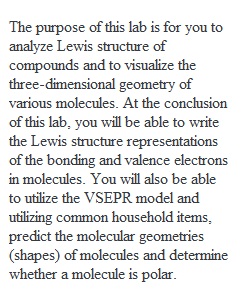


Q Module 7Lab Assignment Objective: The purpose of this lab is for you to analyze Lewis structure of compounds and to visualize the three-dimensional geometry of various molecules. At the conclusion of this lab, you will be able to write the Lewis structure representations of the bonding and valence electrons in molecules. You will also be able to utilize the VSEPR model and utilizing common household items, predict the molecular geometries (shapes) of molecules and determine whether a molecule is polar. Materials: • Marshmallows (mini work best) • Toothpicks • Marker Description: Molecular compounds are formed by sharing electrons between non-metal atoms. A useful theory for understanding the formation of molecular compounds, shapes of molecules and several other properties is called a Lewis dot structure. We will explore the use of Lewis dot theory to generate structures of molecular compounds and to build 3D models in order to predict shapes, and polarity of molecules. Lewis structures are based on the concept that all atoms want filled orbitals. Usually, atoms want to duplicate the 8 valence (or outer) electrons of the noble gases. This is commonly called the Octet Rule. This can be done in two ways. One is to exchange (or transfer) electrons, which is done in the formation of ionic bonds. Another is to share electrons in covalent bonds. Do molecules ever violate the Octet Rule? In this experiment, we will look at shared electrons in covalent bonds. Procedure For each covalent molecule listed in Column 1 of Table 1 on the Module 7 Lab Data Template Download Module 7 Lab Data Template, you will: 1. Count the number of valence (or outer) electrons available for bonding and record in Table 1 (Column 2). 2. For every atom-to-atom connection, make a single bond (a shared electron pair). 3. Distribute the remaining electrons available first to nonbonded pair positions (a maximum of six nonbonded pair electrons per atom, except H, which cannot have nonbonded pairs). Why can H not have nonbonded electrons? 4. Identify atoms that need to have an octet but do not yet have one. 5. Rearrange electrons from nonbonded pairs of adjacent atoms to multiple bonds to satisfy the octet rule on atoms identified in step 4. Count the electrons to make sure that you still have the same number as you started with! Draw your Lewis structure in Table 1 (Column 3). 6. Determine the molecular geometry or shape of the molecule and record in Table 1 (Column 4). 7. Calculate the formal charge of each atom and record in Table 1 (Column 5). 8. Analysis: Are the bonds nonpolar or polar covalent? Does the molecule have an overall dipole moment? How many resonance structures can you draw? Answer each in Table 1 (Columns 6 and 7). 9. Select ten molecules and build using marshmallows, toothpicks, and a marker. ? Label each atom (marshmallow) using a marker with the element’s symbol (see example below): ? Use toothpicks for each bond (one toothpick for a single bond, two toothpicks for a double bond, etc.). ? Build the molecule and clearly label (example with methane): ? Note: This lab will not be conducted in Hayden McNeil simulations. To submit your work: Take a picture of the ten molecules that you built and submit a photo of each with your completed Module 7 Lab Data Template Download Module 7 Lab Data Template. Rubric Module 7 Lab Rubric Module 7 Lab Rubric Criteria Ratings Pts This criterion is linked to a Learning OutcomeContent 15 to >12.0 pts Meets Expectation Demonstrates strong or adequate knowledge of Lewis structures and molecular bonds; correctly represents knowledge from the readings and sources. 12 to >9.0 pts Approaches Expectation Some significant but not major errors or omissions in demonstration of knowledge. 9 to >6.0 pts Below Expectation Major errors or omissions in demonstration of knowledge. 6 to >0 pts Limited Evidence Fails to demonstrate knowledge of the materials. 15 pts This criterion is linked to a Learning OutcomeLab Data Table 15 to >12.0 pts Meets Expectation Includes all of the required components, as specified in the assignment. 12 to >9.0 pts Approaches Expectation Includes most of the required components, as specified in the assignment. 9 to >6.0 pts Below Expectation Includes some of the required components, as specified in the assignment. 6 to >0 pts Limited Evidence Includes few of the required components, as specified in the assignment. 15 pts This criterion is linked to a Learning OutcomeLab Photos 15 to >12.0 pts Meets Expectation Includes all of the required components, as specified in the assignment. 12 to >9.0 pts Approaches Expectation Includes most of the required components, as specified in the assignment. 9 to >6.0 pts Below Expectation Includes some of the required components, as specified in the assignment. 6 to >0 pts Limited Evidence Includes few of the required components, as specified in the assignment. 15 pts Total Points: 45 PreviousNext
View Related Questions